2. Armour M, Parry K, Manohar N, Holmes K, Ferfolja T, Curry C, et al. The prevalence and academic impact of dysmenorrhea in 21,573 young women: a systematic review and meta-analysis. J Womens Health (Larchmt). 2019; 28(8):1161–1171. PMID:
31170024.

3. Banikarim C, Chacko MR, Kelder SH. Prevalence and impact of dysmenorrhea on Hispanic female adolescents. Arch Pediatr Adolesc Med. 2000; 154(12):1226–1229. PMID:
11115307.

4. Iacovides S, Avidon I, Baker FC. What we know about primary dysmenorrhea today: a critical review. Hum Reprod Update. 2015; 21(6):762–778. PMID:
26346058.

5. Kim J. Factors affecting dysmenorrhea in undergraduate students. J Korean Acad Soc Nurs Educ. 2014; 20(2):350–357.

6. Hu Z, Tang L, Chen L, Kaminga AC, Xu H. Prevalence and risk factors associated with primary dysmenorrhea among Chinese female university students: a cross-sectional study. J Pediatr Adolesc Gynecol. 2020; 33(1):15–22. PMID:
31539615.

7. Pejčić A, Janković S. Risk factors for dysmenorrhea among young adult female university students. Ann Ist Super Sanita. 2016; 52(1):98–103. PMID:
27033624.
8. Çaltekin İ, Hamamcı M, Demir Çaltekin M, Onat T. Evaluation of sleep disorders, anxiety and depression in women with dysmenorrhea. Sleep Biol Rhythms. 2021; 19(1):13–21.

9. Qin LL, Hu Z, Kaminga AC, Luo BA, Xu HL, Feng XL, et al. Association between cigarette smoking and the risk of dysmenorrhea: a meta-analysis of observational studies. PLoS One. 2020; 15(4):e0231201. PMID:
32294123.

10. Laxy M, Holle R, Döring A, Peters A, Hunger M. The longitudinal association between weight change and health-related quality of life: the KORA S4/F4 cohort study. Int J Public Health. 2014; 59(2):279–288. PMID:
23999627.

11. Nanri A, Mizoue T, Takahashi Y, Noda M, Inoue M, Tsugane S, et al. Weight change and all-cause, cancer and cardiovascular disease mortality in Japanese men and women: the Japan Public Health Center-Based Prospective Study. Int J Obes. 2010; 34(2):348–356.

12. Greenberg BS, Eastin M, Hofschire L, Lachlan K, Brownell KD. Portrayals of overweight and obese individuals on commercial television. Am J Public Health. 2003; 93(8):1342–1348. PMID:
12893625.

13. Yates A, Edman J, Aruguete M. Ethnic differences in BMI and body/self-dissatisfaction among Whites, Asian subgroups, Pacific Islanders, and African-Americans. J Adolesc Health. 2004; 34(4):300–307. PMID:
15040999.

14. Wardle J, Haase AM, Steptoe A. Body image and weight control in young adults: international comparisons in university students from 22 countries. Int J Obes. 2006; 30(4):644–651.

15. Noh JW, Kwon YD, Yang Y, Cheon J, Kim J. Relationship between body image and weight status in east Asian countries: comparison between South Korea and Taiwan. BMC Public Health. 2018; 18(1):814. PMID:
29970058.

16. Talamayan KS, Springer AE, Kelder SH, Gorospe EC, Joye KA. Prevalence of overweight misperception and weight control behaviors among normal weight adolescents in the United States. Sci World J. 2006; 6:365–373.

17. Park B, Cho HN, Choi E, Seo DH, Kim NS, Park E, et al. Weight control behaviors according to body weight status and accuracy of weight perceptions among Korean women: a nationwide population-based survey. Sci Rep. 2019; 9(1):9127. PMID:
31235742.

18. Cho HN, Choi E, Seo DH, Suh M, Lee HY, Park B, et al. The Korean Study of Women’s Health-Related Issues (K-Stori): rationale and study design. BMC Public Health. 2017; 17(1):609. PMID:
28662652.

20. Hawker GA, Mian S, Kendzerska T, French M. Measures of adult pain: Visual Analog Scale for Pain (VAS Pain), Numeric Rating Scale for Pain (NRS Pain), McGill Pain Questionnaire (MPQ), Short-Form McGill Pain Questionnaire (SF-MPQ), Chronic Pain Grade Scale (CPGS), Short Form-36 Bodily Pain Scale (SF-36 BPS), and Measure of Intermittent and Constant Osteoarthritis Pain (ICOAP). Arthritis Care Res (Hoboken). 2011; 63(Suppl 11):S240–S252. PMID:
22588748.
21. Aubrun F, Langeron O, Quesnel C, Coriat P, Riou B. Relationships between measurement of pain using visual analog score and morphine requirements during postoperative intravenous morphine titration. Anesthesiology. 2003; 98(6):1415–1421. PMID:
12766651.

22. Kazama M, Maruyama K, Nakamura K. Prevalence of dysmenorrhea and its correlating lifestyle factors in Japanese female junior high school students. Tohoku J Exp Med. 2015; 236(2):107–113. PMID:
26027596.

23. Korea Disease Control and Prevention Agency. The Korea National Health and Nutrition Examination Survey VI (2013–2015) Analysis Guideline. Cheongju, Korea: Korea Disease Control and Prevention Agency;2015.
24. Jang HJ, Kim BS, Won CW, Kim SY, Seo MW. The relationship between psychological factors and weight gain. Korean J Fam Med. 2020; 41(6):381–386. PMID:
32403901.

25. Neumark-Sztainer D, Croll J, Story M, Hannan PJ, French SA, Perry C. Ethnic/racial differences in weight-related concerns and behaviors among adolescent girls and boys: findings from Project EAT. J Psychosom Res. 2002; 53(5):963–974. PMID:
12445586.

26. Regier DA, Kuhl EA, Kupfer DJ. The DSM-5: classification and criteria changes. World Psychiatry. 2013; 12(2):92–98. PMID:
23737408.

28. Buysse DJ, Reynolds CF 3rd, Monk TH, Berman SR, Kupfer DJ. The Pittsburgh Sleep Quality Index: a new instrument for psychiatric practice and research. Psychiatry Res. 1989; 28(2):193–213. PMID:
2748771.

29. The American College of Obstetricians and Gynecologists (ACOG). Guidelines for Women’s Health Care: A Resource Manual. 4th ed. Washington, D.C., USA: American College of Obstetricians and Gynecologists;2014. p. 607–613. .
30. WHO. World Health Survey 2002: Individual Questionnaire. Geneva, Switzerland: World Health Organization;2002.
31. Lee EH, Chung BY, Suh CH, Jung JY. Korean versions of the Perceived Stress Scale (PSS-14, 10 and 4): psychometric evaluation in patients with chronic disease. Scand J Caring Sci. 2015; 29(1):183–192. PMID:
24660854.

32. Kroenke K, Spitzer RL, Williams JB. The PHQ-9: validity of a brief depression severity measure. J Gen Intern Med. 2001; 16(9):606–613. PMID:
11556941.
33. Friederich MA. Dysmenorrhea. Women Health. 1983; 8(2-3):91–106. PMID:
6685410.

34. Pickles VR, Hall WJ, Best FA, Smith GN. Prostaglandins in endometrium and menstrual fluid from normal and dysmenorrhoeic subjects. J Obstet Gynaecol Br Commonw. 1965; 72(2):185–192. PMID:
14273094.

35. Fajrin I, Alam G, Usman AN. Prostaglandin level of primary dysmenorrhea pain sufferers. Enferm Clin. 2020; 30(2):5–9.

36. Strömberg P, Åkerlund M, Forsling ML, Granström E, Kindahl H. Vasopressin and prostaglandins in premenstrual pain and primary dysmenorrhea. Acta Obstet Gynecol Scand. 1984; 63(6):533–538. PMID:
6542295.

37. Neumark-Sztainer D, Wall M, Story M, Standish AR. Dieting and unhealthy weight control behaviors during adolescence: associations with 10-year changes in body mass index. J Adolesc Health. 2012; 50(1):80–86. PMID:
22188838.

38. Bougoulia M, Triantos A, Koliakos G. Plasma interleukin-6 levels, glutathione peroxidase and isoprostane in obese women before and after weight loss. Association with cardiovascular risk factors. Hormones (Athens). 2006; 5(3):192–199. PMID:
16950753.

39. Campión J, Milagro FI, Goyenechea E, Martínez JA. TNF-α promoter methylation as a predictive biomarker for weight-loss response. Obesity (Silver Spring). 2009; 17(6):1293–1297. PMID:
19584886.

40. Morris FL, Payne WR, Wark JD. Prospective decrease in progesterone concentrations in female lightweight rowers during the competition season compared with the off season: a controlled study examining weight loss and intensive exercise. Br J Sports Med. 1999; 33(6):417–422. PMID:
10597853.

41. Falsetti L, Pasinetti E, Mazzani MD, Gastaldi A. Weight loss and menstrual cycle: clinical and endocrinological evaluation. Gynecol Endocrinol. 1992; 6(1):49–56. PMID:
1580168.

42. Grulović B, Pucelj MR, Krnić M, Kokić V. Impact of prostaglandin F2-alpha and tumor necrosis factor-alpha (TNF-alpha) on pain in patients undergoing thermal balloon endometrial ablation. Coll Antropol. 2013; 37(4):1185–1190. PMID:
24611332.
43. Whitcomb BW, Mumford SL, Perkins NJ, Wactawski-Wende J, Bertone-Johnson ER, Lynch KE, et al. Urinary cytokine and chemokine profiles across the menstrual cycle in healthy reproductive-aged women. Fertil Steril. 2014; 101(5):1383–1391. PMID:
24581581.
44. Maybin JA, Critchley HO. Progesterone: a pivotal hormone at menstruation. Ann N Y Acad Sci. 2011; 1221(1):88–97. PMID:
21401635.

45. Kannan P, Cheung KK, Lau BW. Does aerobic exercise induced-analgesia occur through hormone and inflammatory cytokine-mediated mechanisms in primary dysmenorrhea? Med Hypotheses. 2019; 123:50–54. PMID:
30696591.

46. Tavallaee M, Joffres MR, Corber SJ, Bayanzadeh M, Rad MM. The prevalence of menstrual pain and associated risk factors among Iranian women. J Obstet Gynaecol Res. 2011; 37(5):442–451. PMID:
21208343.

47. Wolfson JA, Bleich SN. Is cooking at home associated with better diet quality or weight-loss intention? Public Health Nutr. 2015; 18(8):1397–1406. PMID:
25399031.

48. Bianco V, Cestari AM, Casati D, Cipriani S, Radici G, Valente I. Premenstrual syndrome and beyond: lifestyle, nutrition, and personal facts. Minerva Ginecol. 2014; 66(4):365–375. PMID:
25020055.
49. Wang L, Wang X, Wang W, Chen C, Ronnennberg AG, Guang W, et al. Stress and dysmenorrhoea: a population based prospective study. Occup Environ Med. 2004; 61(12):1021–1026. PMID:
15550609.

50. Bajalan Z, Moafi F, MoradiBaglooei M, Alimoradi Z. Mental health and primary dysmenorrhea: a systematic review. J Psychosom Obstet Gynaecol. 2019; 40(3):185–194. PMID:
29745745.

51. Kitamura M, Takeda T, Koga S, Nagase S, Yaegashi N. Relationship between premenstrual symptoms and dysmenorrhea in Japanese high school students. Arch Women Ment Health. 2012; 15(2):131–133.

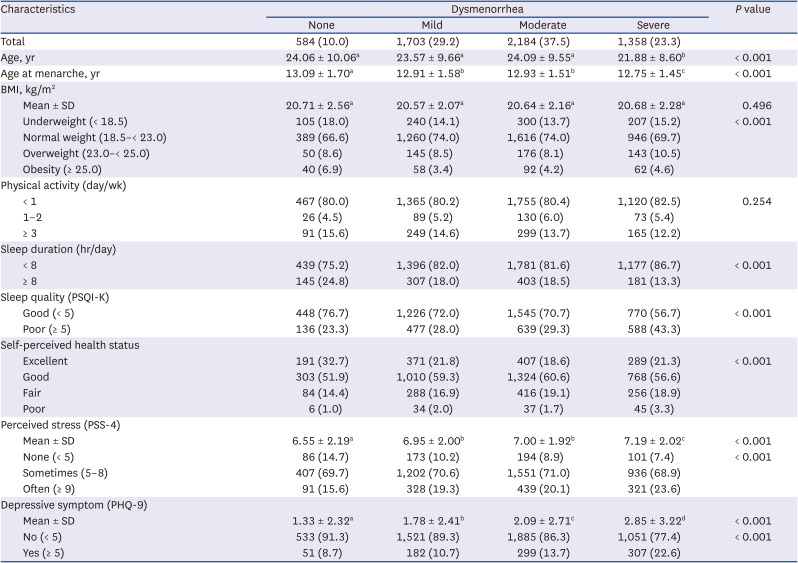
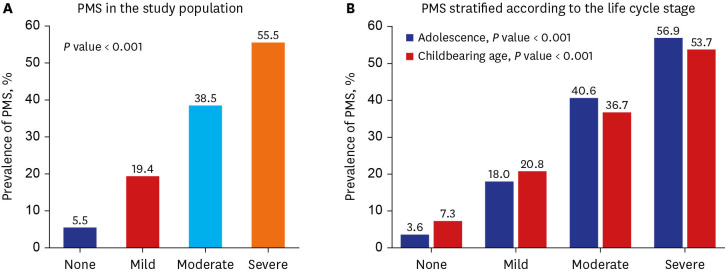
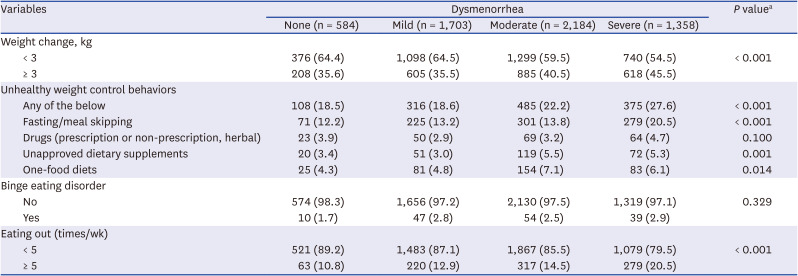
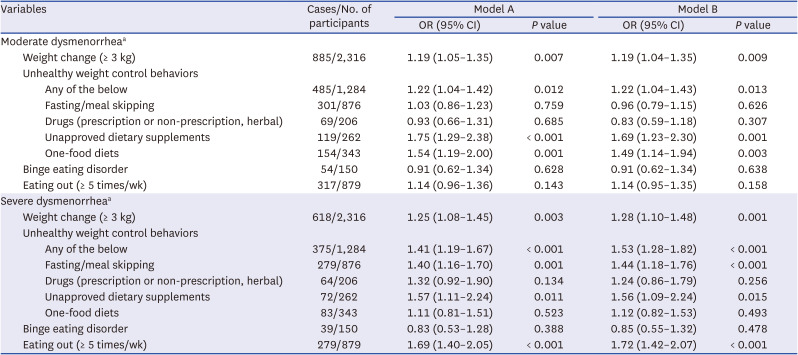




 PDF
PDF Citation
Citation Print
Print



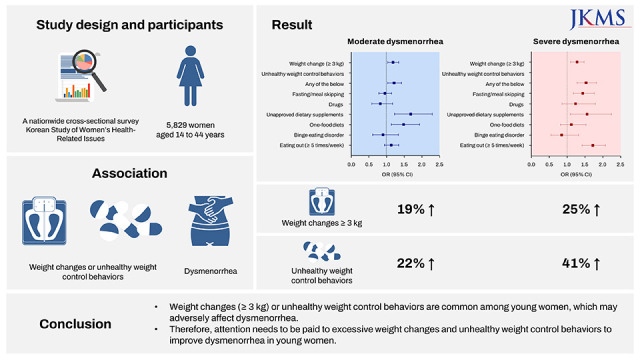
 XML Download
XML Download